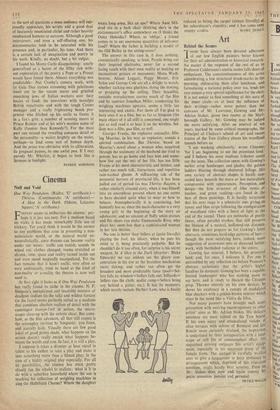Art
Behind the Scenes I.. HERE have always been devoted adherents of our few English painters better known for their art administration or historical research. No matter if the response of the rest of us to Professor Coldstream's ascetic nudes falls short of enthusiasm. The conscientiousness of this artist adumbrating a few structural brush-marks in the morning, obliterating them after luncheon, and formulating a national policy over tea, lends his rare output a very special significance for the elect. It is not unfair to find something of this aura of the inner circle—or at least the influence of their writings—rather more potent than the canvases of Mr. Lawrence, Gowing and Mr. Adrian Stokes, given two rooms at the Marl- borough Gallery. Mr. Gowing may be judged the more satisfying. After an interval of ten years, marked by some critical monographs, the Principal of Chelsea's school of art and recent trustee of the Tate Gallery places his woodland tunnels before us.
'I am working obstinately,' wrote Cezanne, 'for I am beginning to see the promised land,' and I believe his most studious follower could say the same. The collection opens with Cowing's earlier crisp landscapes and glades, the golden ladders filtering through shuttered foliage. His own variety of abstract shapes is barely con- cealed here beneath the more or less naturalistic compromise with appearances. Perception and design—the firm structure of lithe stems of lumber, and green vaulting—are fused in the best of these paintings. It is hardly surprising that his next stage is a schematic one, giving us tawny and blue strips following the configuration of woodland rides with a burst of light at the end of the tunnel. These are networks of purely linear, often parallel strokes, that still preserve the illusion of a natural, hollowed-out distance. .t But they do not prepare us for Gowing's latest . abstracts, sometimes hard-edge patterns of bars! though the most -satisfying have, indeed, some suggestion of cavernous nets or diamond lattice- work, with burdishtd radiance at the'centre.
Gowing has entered, I believe, his promised land; and, for once, I welcome it. For one is untroubled by any reflection (as before Pasmore's abstract variations) that the artist's higher faculties lie dormant. Gowing has been a capable, limited landscapist who has nothing more to say here, and is ready to discard the Cezanne prop. Thrown entirely on his own devices, he shows his exultancy in a canopy of modulated blue checkers with a golden-brown interior which stays in the mind like a Vieira da Silva.
Not many painters have brought such acute perception with untiring encouragement to other artists' aims as Mr. Adrian Stokes. His delicate antennae are most valued on the Tate board. If his own misty and emasculated visions of olive terraces with echoes of Bonnard and late Renoir seem curiously strained, the impression is underlined by their juxtaposition with a land- scape or still life of commonplace effect. His anguished striving outpaces this artist's equip- ment, especially' in his uncertain grasp of the female form. The surface is carefully worked over to give a languorous or hazy ambience to arrangements which, deprived of this iridescent envelope, might hardly bear 'scrutiny. Even so, Mr. Stokes does now and again convey his petite sensation, pensive and personal.
NEVILE WALLIS


































 Previous page
Previous page